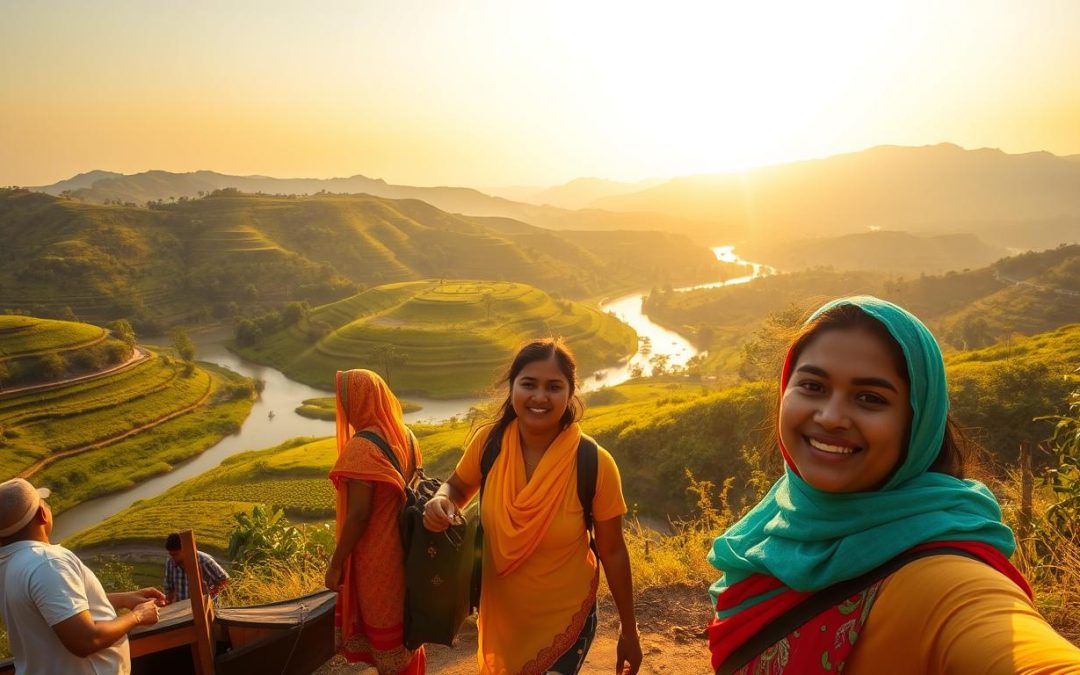Have you ever wondered how to experience a destination in perfect harmony with its climate? Planning your journey around the right time can make all the difference. This is especially true for a place like Bangladesh, where the weather shapes not just the landscape but also the culture and daily life.
From the lush greenery of the monsoon season to the crisp, pleasant air of winter, this country offers a dynamic blend of experiences. Knowing the ideal time to visit ensures you can enjoy local festivals, explore natural wonders, and avoid weather-related challenges.
In this guide, we’ll walk you through the seasonal trends, travel tips, and cost considerations. Whether you’re drawn to the vibrant energy of the monsoon or the serene beauty of winter, you’ll discover how to make the most of your trip. Let’s dive into what makes this destination a weather-savvy traveler’s dream.
Key Takeaways
- Understanding the monsoon season helps you plan around heavy rains and lush landscapes.
- Winter offers pleasant temperatures, ideal for exploring cultural sites and festivals.
- Summer can be hot and humid, but it’s a great time to enjoy tropical fruits.
- Local transportation options vary by season, so plan accordingly.
- Timing your visit around festivals enhances your cultural experience.
Understanding Bangladesh’s Climate and Seasonal Patterns
The weather in a place shapes its culture, landscape, and daily life. In this country, the climate is heavily influenced by its position in the Ganges Delta. This makes it prone to heavy rainfall and seasonal shifts that define the year.
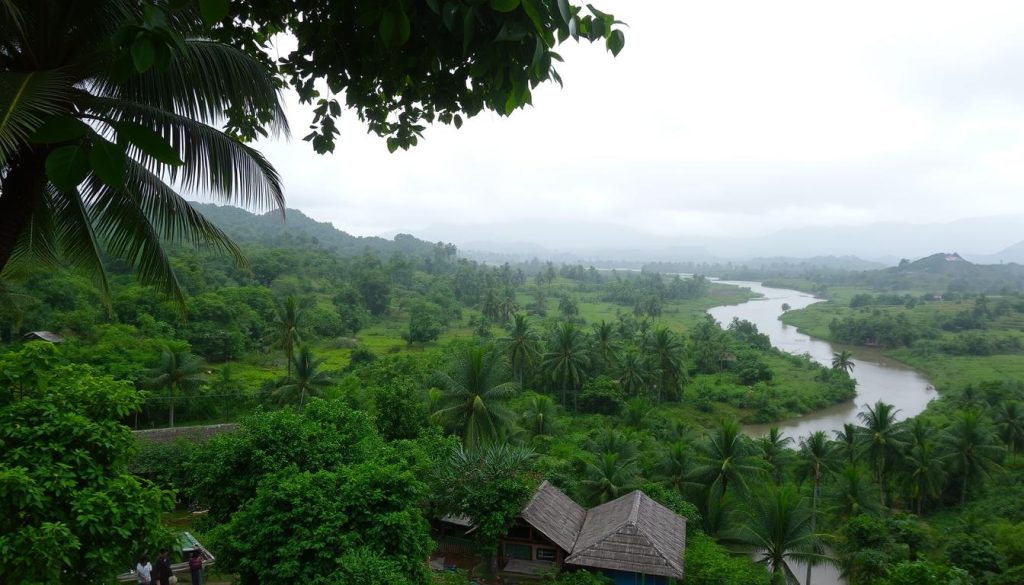
An Overview of Weather and Monsoon Trends
The monsoon season plays a critical role here. From June to September, heavy rains transform the landscape into lush greenery. This period is both beautiful and challenging, as it impacts travel and local life.
In Dhaka, the capital, the monsoon brings extreme humidity and occasional flooding. Rural areas, however, experience a different rhythm. Villages adapt to the rains, relying on them for agriculture while navigating their challenges.
Seasonal Variations: Summer, Monsoon, Autumn, and Winter Insights
Each month brings unique weather patterns. Summers are hot and humid, with temperatures often exceeding 90°F. This is a great time to enjoy tropical fruits but can be uncomfortable for outdoor activities.
Autumn offers a brief respite with milder temperatures. Winter, from December to February, is the most pleasant season. Cooler weather makes it ideal for exploring cultural sites and festivals.
The Sundarbans, a UNESCO World Heritage Site, showcases these seasonal changes. During the monsoon, the mangrove forests are lush and vibrant. In winter, the drier conditions make it easier to explore this natural wonder.
| Season | Characteristics |
|---|---|
| Summer | Hot, humid, ideal for tropical fruits |
| Monsoon | Heavy rains, lush landscapes, occasional flooding |
| Autumn | Mild temperatures, transitional weather |
| Winter | Cool, pleasant, perfect for festivals and exploration |
Seasonal shifts also influence local customs and festivals. The monsoon inspires vibrant celebrations, while winter hosts cultural events. Understanding these patterns helps you plan a trip that aligns with the rhythm of the place.
Planning Your Trip: Weather-Sensitive Preparations
Traveling smart means preparing for the unexpected, especially when it comes to weather. Whether you’re exploring lush landscapes or bustling cities, being weather-savvy ensures a smooth and enjoyable journey. Here’s how to pack, plan, and stay safe while embracing the local climate.
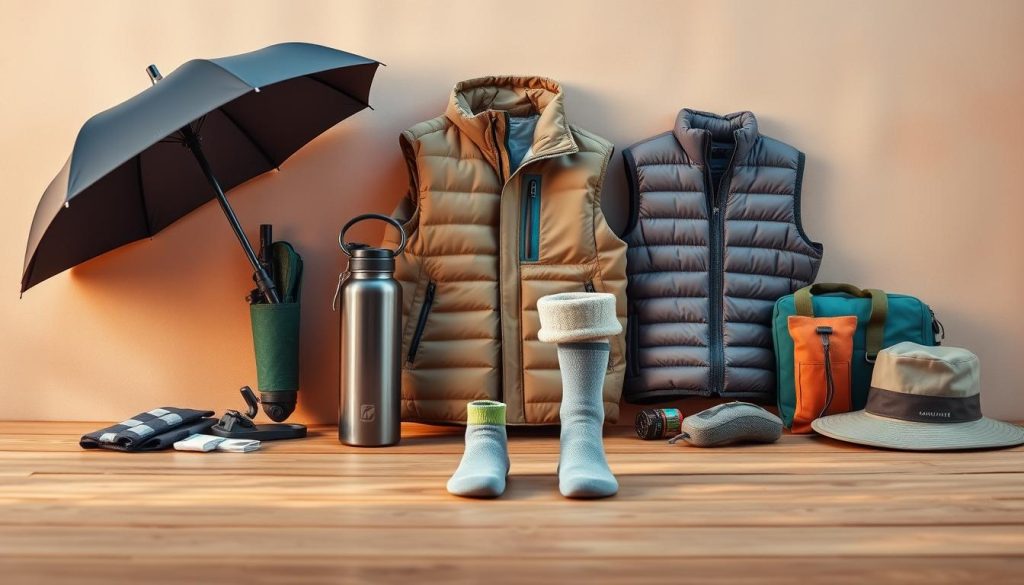
Packing Essentials for Rainy, Sunny, and Cold Months
Your packing list should match the season. For rainy months, waterproof bags and quick-dry clothing are a must. Don’t forget a head torch for power cuts, which are common in some areas.
In sunny months, sunscreen and a wide-brimmed hat are essential. Lightweight, breathable fabrics will keep you comfortable in the heat. For cooler months, layer up with warm clothing and a sturdy jacket.
Here’s a quick guide to help you pack:
| Season | Essentials |
|---|---|
| Rainy | Waterproof bags, quick-dry clothes, head torch |
| Sunny | Sunscreen, hat, lightweight fabrics |
| Cold | Layered clothing, warm jacket, gloves |
Visa, Local Customs, and Safety Tips
Before you travel, ensure your visa is in order. Check the requirements and allow ample time for processing. Keep digital and physical copies of your documents safe.
Understanding local customs is key to blending in. Dress modestly, especially in rural areas, and avoid public displays of affection. Bargaining is common in markets, but always stay respectful.
Safety is paramount. Stay updated on weather forecasts and local advice. Carry a first-aid kit and avoid tap water—stick to bottled water from reputable brands.
Here are a few reminders:
- Apply for your visa early and keep copies of your documents.
- Respect local customs and dress appropriately.
- Stay informed about weather conditions and safety advisories.
By preparing for the weather and understanding local norms, you’ll maximize your comfort and enjoy your trip to the fullest.
Bangladesh: Best Months for a Weather-Savvy Trip
Timing your visit to match the ideal climate can transform your travel experience. Whether you’re drawn to the cool winter breeze or the lush greenery of the monsoon, understanding seasonal trends helps you plan better. Let’s explore the best travel windows and cost insights to make your trip seamless.
Identifying the Optimal Travel Windows
Each season offers unique advantages. Winter, from December to February, is the most popular time to visit. The pleasant temperature makes it ideal for exploring cultural sites and festivals. However, this is also the peak season, so expect higher costs for flights and accommodations.
If you prefer fewer crowds, consider the shoulder seasons of autumn or spring. These months offer milder weather and lower prices. The mangrove forests and river routes are particularly stunning during these times, making them perfect for nature lovers.
Seasonal Cost Analysis: Flights and Accommodation Insights
Travel costs vary significantly by season. During winter, airfare and hotel rates can spike due to high demand. For example, flights from the U.S. may cost 20-30% more compared to off-peak months. Booking early can help you secure better deals.
In contrast, the monsoon season offers budget-friendly options. While heavy rains may limit some activities, you’ll find discounted rates on accommodations and flights. This is a great time to explore indoor attractions and immerse yourself in Bengali culture.
Here’s a quick comparison of seasonal costs:
| Season | Flight Cost | Hotel Cost |
|---|---|---|
| Winter | High | High |
| Monsoon | Low | Low |
| Autumn | Moderate | Moderate |
Planning ahead is crucial, especially if you’re traveling during peak or off-peak months. Early bookings can save you money and ensure availability.
Experiencing Local Culture and Natural Attractions
Exploring a destination’s culture and natural beauty is a journey into its heart and soul. From lush forests to vibrant festivals, every corner offers a story waiting to be discovered. Whether you’re drawn to serene landscapes or bustling cultural hubs, this section will guide you through the must-see spots and experiences.
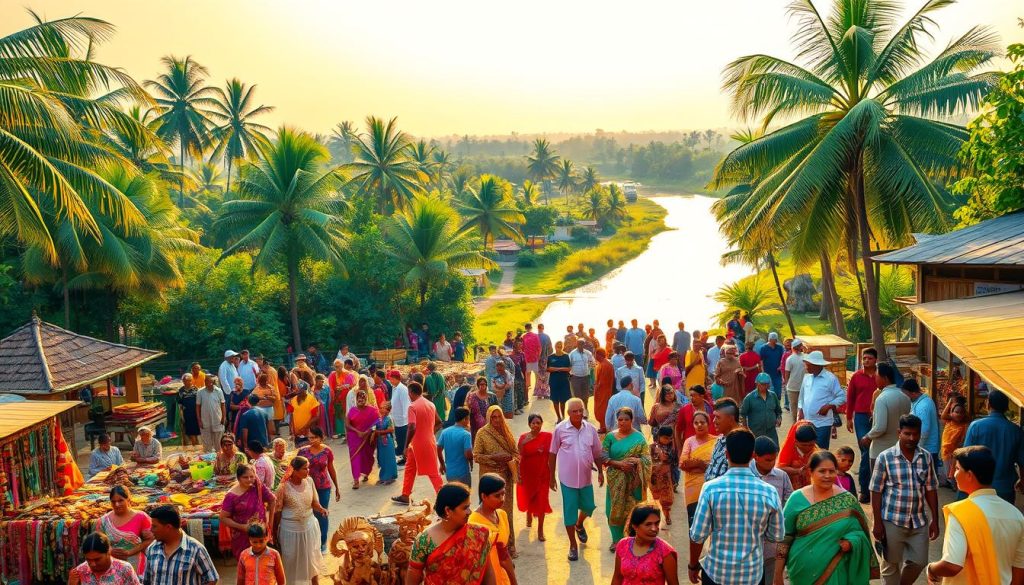
Must-Visit Destinations: Sundarbans, Tea Estates, and Historical Sites
The Sundarbans, a UNESCO World Heritage Site, is a natural wonder you can’t miss. Home to the majestic Royal Bengal Tiger, this mangrove forest is a paradise for wildlife enthusiasts. Visiting hours are from 9 AM to 5 PM, making it easy to plan your day.
Srimongol’s tea estates are another highlight. Known as the tea capital, this region offers breathtaking views and a chance to learn about tea production. Don’t forget to sample a fresh brew while you’re there.
For history buffs, the Bikrampur Museum is a treasure trove of artifacts. With ticket prices at BDT 50 for adults and BDT 20 for children, it’s an affordable way to dive into the past.
Cultural Festivals and Local Experiences Throughout the Year
Local events like the Nabanna Festival in November celebrate the harvest season. This vibrant event is a window into rural life and traditions. It’s a must-see for anyone looking to immerse themselves in the culture.
Summer is ideal for coastal exploration. Cox’s Bazaar, the longest natural beach in the world, is perfect for sunbathing and water sports. The warm weather makes it a popular spot for both locals and tourists.
Learning basic phrases in the local language can enhance your experience. Simple greetings go a long way in connecting with people and understanding their way of life.
| Attraction | Best Time to Visit | Key Highlights |
|---|---|---|
| Sundarbans | November to February | Wildlife, mangrove forests |
| Srimongol Tea Estates | Year-round | Tea production, scenic views |
| Bikrampur Museum | 9 AM – 5 PM | Historical artifacts |
| Cox’s Bazaar | Summer | Beach activities, warm weather |
Budget Considerations and Seasonal Travel Costs
Understanding seasonal costs can help you plan a trip that fits your budget perfectly. Whether you’re traveling during the rainy monsoon or the cool winter, knowing the cost differences ensures you get the most value for your money. Let’s break down the expenses across summer, monsoon, autumn, and winter to help you make informed decisions.
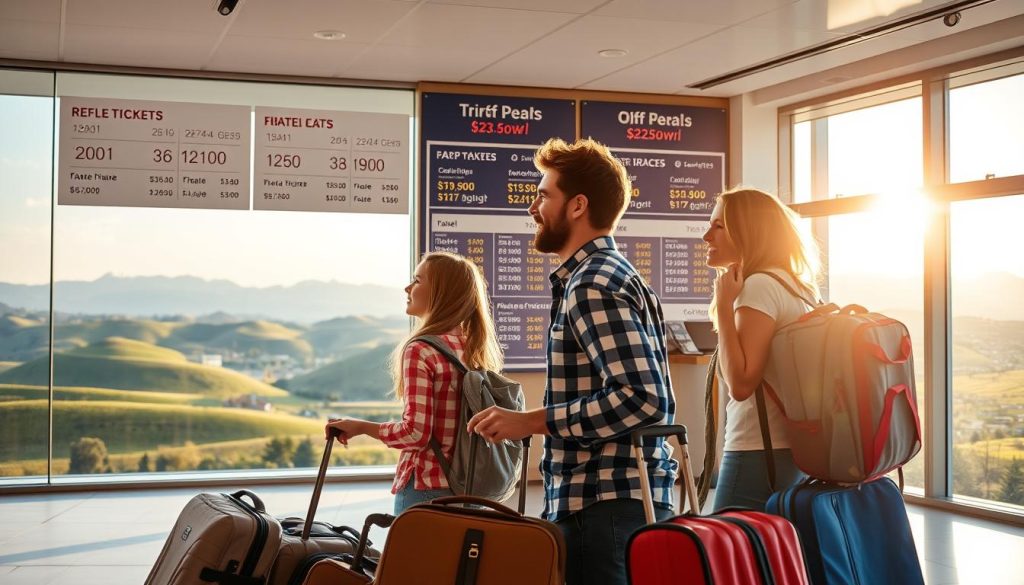
Comparing Costs Across Summer, Monsoon, Autumn, and Winter
Travel costs vary significantly depending on the season. Winter, from December to February, is the most popular time to visit. While the weather is pleasant, expect higher flight and accommodation prices. Booking early can help you secure better deals.
In contrast, the monsoon season offers budget-friendly options. Heavy rains may limit some activities, but you’ll find discounted rates on flights and hotels. This is a great time to explore indoor attractions and immerse yourself in local culture.
Summer can be hot and humid, but it’s a more affordable alternative to winter. Autumn, with its milder weather, strikes a balance between cost and comfort. Here’s a quick comparison:
| Season | Flight Cost | Hotel Cost |
|---|---|---|
| Winter | High | High |
| Monsoon | Low | Low |
| Summer | Moderate | Moderate |
| Autumn | Moderate | Moderate |
For budget-conscious travelers, the monsoon season is a hidden gem. Despite the heavy rains, you can enjoy significant savings. Plus, the lush landscapes and vibrant greenery make for a unique experience.
Cost-Effective Strategies for Exploring Natural Attractions
Exploring natural wonders like the mangrove forests doesn’t have to break the bank. Opt for river cruises during the monsoon or autumn months when prices are lower. These trips often include wildlife spotting, and you might even catch a glimpse of the majestic Bengal tiger.
Public transportation is another way to save money. Buses and trains are affordable and connect major cities with rural areas. For shorter distances, consider renting a bike or walking to fully immerse yourself in the surroundings.
By understanding these seasonal trends, you can plan a trip that maximizes your budget while offering unforgettable experiences. Whether you’re drawn to the vibrant monsoon or the serene winter, careful planning ensures you get the best value for your travel budget.
Local Transportation and On-Ground Navigation
Navigating a new place can be both exciting and challenging, especially when it comes to transportation. Whether you’re exploring a bustling city or venturing into serene hill areas, understanding your options ensures a smooth journey. From boats to bikes, each mode of transport offers a unique way to experience the destination.
Exploring by Boat, Bike, and Public Transit
Boat travel is a popular choice, especially along the Jamuna River. It’s not only scenic but also practical for reaching remote areas. In June, when the monsoon season begins, river routes become even more vibrant.
Biking is another great option, particularly in smaller cities. Renting a bike allows you to explore at your own pace and discover hidden gems. For longer distances, public transit like buses and trains is affordable and widely available.
Here’s a quick guide to transportation options:
| Mode | Best For | Tips |
|---|---|---|
| Boat | Scenic routes, remote areas | Check weather conditions in June |
| Bike | City tours, short distances | Wear a helmet and stay on marked roads |
| Public Transit | Long distances, budget travel | Avoid peak hours for a smoother ride |
Tips to Avoid Common Travel Pitfalls
Traveling at night can be tricky, especially in unfamiliar areas. Stick to well-lit roads and avoid isolated spots. If you’re using public transit, plan your route in advance to avoid delays.
Understanding local driving behaviors is also crucial. In busy cities, traffic can be chaotic, so stay alert. If you’re renting a bike or car, ensure you’re familiar with the rules of the road.
Here are some additional tips:
- Carry a map or use a reliable GPS app.
- Ask locals for advice—they often know the best routes.
- Be cautious when traveling in June, as monsoon rains can affect transportation.
By mastering local transportation, you’ll not only save time but also enjoy a richer travel experience. Whether you’re cruising on a boat or biking through a city, these tips will help you navigate with confidence.
Tips for Immersing Yourself in Bangladeshi Life
Immersing yourself in a new culture is about more than just sightseeing—it’s about connecting with people and traditions. In this vibrant destination, you’ll find warmth and hospitality at every turn. Here’s how to make the most of your experience while respecting local customs and embracing the unique way of life.
Engaging with Locals and Embracing Cultural Etiquette
Building genuine connections starts with respect. Greet locals with a smile and a simple “Salaam” to show friendliness. Dress modestly, especially in rural areas, to align with cultural norms. Avoid public displays of affection, as they are uncommon in this Bangladeshi society.
When visiting homes, remove your shoes before entering. This small gesture shows consideration for local customs. If invited to a meal, try to accept—it’s a sign of hospitality and trust. Remember to use your right hand for eating and passing items, as the left is considered impolite.
Here are a few tips to connect authentically:
- Learn basic phrases in the local language to break the ice.
- Ask questions about traditions—locals love sharing their culture.
- Be mindful of religious practices, especially during prayer times.
Sampling Traditional Cuisine and Unique Local Events
Food is a gateway to understanding any culture. In this Bengal region, meals are a celebration of flavors and traditions. Try dishes like hilsa fish curry, a local delicacy, or pitha, a sweet rice cake often enjoyed during festivals. Street food like fuchka (pani puri) is a must-try for adventurous eaters.
Seasonal events offer a deeper glimpse into local life. The Bengali New Year, celebrated in April, is a vibrant festival filled with music, dance, and colorful processions. During the monsoon, the Nabanna Festival celebrates the harvest with traditional rituals and feasts.
For an immersive stay, consider unique accommodation options like NGO guesthouses or houseboats. These not only provide comfort but also support local communities. If you’re lucky, you might even spot the majestic Bengal tiger in its natural habitat, a highlight for any wildlife enthusiast.
Here’s a quick guide to enriching your experience:
| Activity | Best Time |
|---|---|
| Try traditional cuisine | Year-round |
| Attend local festivals | April (New Year), November (Nabanna) |
| Stay in NGO guesthouses | Any season |
By embracing these tips, you’ll not only enjoy your journey but also leave a positive impact on the communities you visit. Remember, safety and mutual respect are key to a meaningful cultural exchange.
Conclusion
Discovering the rhythm of a place through its seasons can make your journey unforgettable. Whether you’re drawn to the cool breeze of winter or the lush greenery of the monsoon, understanding seasonal differences enhances your experience. Planning your trip around weather, cost, and cultural events ensures you make the most of your adventure.
From vibrant festivals to serene landscapes, this destination offers a unique blend of modern convenience and rich heritage. Being well-prepared allows you to fully immerse yourself in the local life, creating memories that last a lifetime. Use the detailed insights provided to plan smartly and embrace the beauty of each season.
Ready to explore? With newfound knowledge, you’re set to experience this vibrant destination in all its glory. Start planning today and let the rhythm of the seasons guide your journey.
The above is subject to change.
Check back often to TRAVEL.COM for the latest travel tips and deals.
Here are some Tours & Sightseeing suggestions that might pique your interests!
